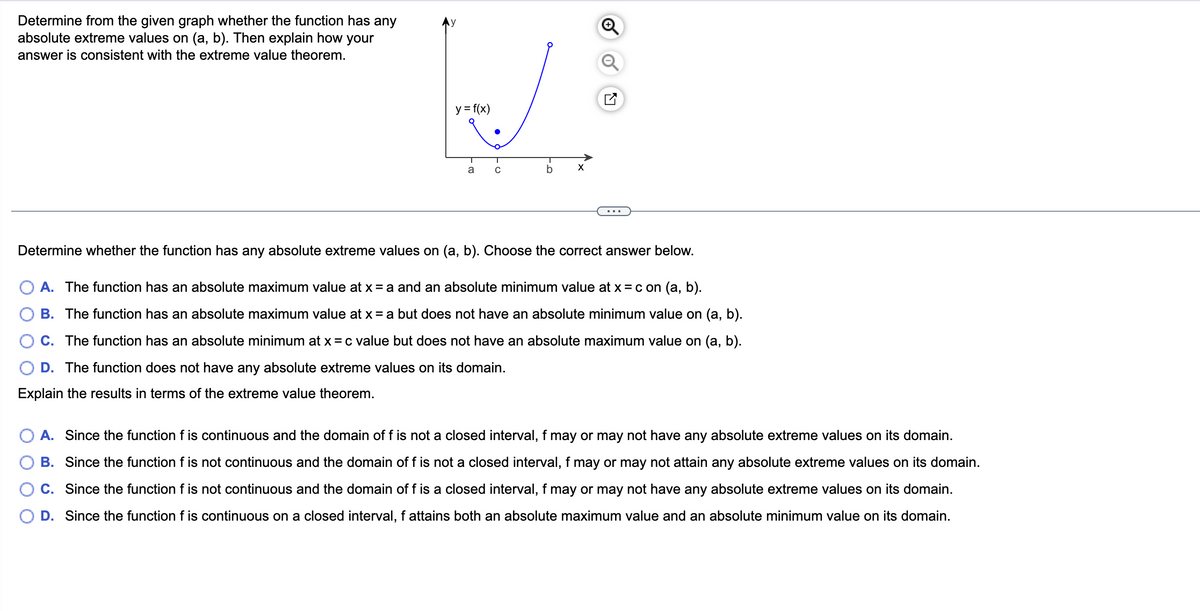termine from the given graph whether the function has any solute extreme values on (a, b). Then explain how your swer is consistent with the extreme value theorem. y=f(x) a C termine whether the function has any absolute extreme values on (a, b). Choose the correct answer below. A. The function has an absolute maximum value at x = a and an absolute minimum value at x = c on (a, b). B. The function has an absolute maximum value at x = a but does not have an absolute minimum value on (a, b). C. The function has an absolute minimum at x = c value but does not have an absolute maximum value on (a, b). D. The function does not have any absolute extreme values on its domain. plain the results in terms of the extreme value theorem. A. Since the function f is continuous and the domain of f is not a closed interval, f may or may not have any absolute extreme values on its domain. B. Since the function f is not continuous and the domain of f is not a closed interval, f may or may not attain any absolute extreme values on its domain. C. Since the function f is not continuous and the domain of f is a closed interval, f may or may not have any absolute extreme values on its domain. D. Since the function f is continuous on a closed interval, f attains both an absolute maximum value and an absolute minimum value on its domain.
termine from the given graph whether the function has any solute extreme values on (a, b). Then explain how your swer is consistent with the extreme value theorem. y=f(x) a C termine whether the function has any absolute extreme values on (a, b). Choose the correct answer below. A. The function has an absolute maximum value at x = a and an absolute minimum value at x = c on (a, b). B. The function has an absolute maximum value at x = a but does not have an absolute minimum value on (a, b). C. The function has an absolute minimum at x = c value but does not have an absolute maximum value on (a, b). D. The function does not have any absolute extreme values on its domain. plain the results in terms of the extreme value theorem. A. Since the function f is continuous and the domain of f is not a closed interval, f may or may not have any absolute extreme values on its domain. B. Since the function f is not continuous and the domain of f is not a closed interval, f may or may not attain any absolute extreme values on its domain. C. Since the function f is not continuous and the domain of f is a closed interval, f may or may not have any absolute extreme values on its domain. D. Since the function f is continuous on a closed interval, f attains both an absolute maximum value and an absolute minimum value on its domain.
College Algebra
7th Edition
ISBN:9781305115545
Author:James Stewart, Lothar Redlin, Saleem Watson
Publisher:James Stewart, Lothar Redlin, Saleem Watson
Chapter3: Polynomial And Rational Functions
Section3.1: Quadratic Functions And Models
Problem 56E: When a certain drug is taken orally, the concentration of the drug in the patient's bloodstream...
Related questions
Question

Transcribed Image Text:Determine from the given graph whether the function has any
absolute extreme values on (a, b). Then explain how your
answer is consistent with the extreme value theorem.
y = f(x)
a
C
X
Determine whether the function has any absolute extreme values on (a, b). Choose the correct answer below.
A. The function has an absolute maximum value at x = a and an absolute minimum value at x = c on (a, b).
B. The function has an absolute maximum value at x = a but does not have an absolute minimum value on (a, b).
C. The function has an absolute minimum at x = c value but does not have an absolute maximum value on (a, b).
D. The function does not have any absolute extreme values on its domain.
Explain the results in terms of the extreme value theorem.
A. Since the function f is continuous and the domain of f is not a closed interval, f may or may not have any absolute extreme values on its domain.
B. Since the function f is not continuous and the domain of f is not a closed interval, f may or may not attain any absolute extreme values on its domain.
Since the function f is not continuous and the domain of f is a closed interval, f may or may not have any absolute extreme values on its domain.
D. Since the function f is continuous on a closed interval, f attains both an absolute maximum value and an absolute minimum value on its domain.
C.
Expert Solution
This question has been solved!
Explore an expertly crafted, step-by-step solution for a thorough understanding of key concepts.
Step by step
Solved in 2 steps with 2 images

Recommended textbooks for you

College Algebra
Algebra
ISBN:
9781305115545
Author:
James Stewart, Lothar Redlin, Saleem Watson
Publisher:
Cengage Learning

College Algebra (MindTap Course List)
Algebra
ISBN:
9781305652231
Author:
R. David Gustafson, Jeff Hughes
Publisher:
Cengage Learning

Functions and Change: A Modeling Approach to Coll…
Algebra
ISBN:
9781337111348
Author:
Bruce Crauder, Benny Evans, Alan Noell
Publisher:
Cengage Learning

College Algebra
Algebra
ISBN:
9781305115545
Author:
James Stewart, Lothar Redlin, Saleem Watson
Publisher:
Cengage Learning

College Algebra (MindTap Course List)
Algebra
ISBN:
9781305652231
Author:
R. David Gustafson, Jeff Hughes
Publisher:
Cengage Learning

Functions and Change: A Modeling Approach to Coll…
Algebra
ISBN:
9781337111348
Author:
Bruce Crauder, Benny Evans, Alan Noell
Publisher:
Cengage Learning
